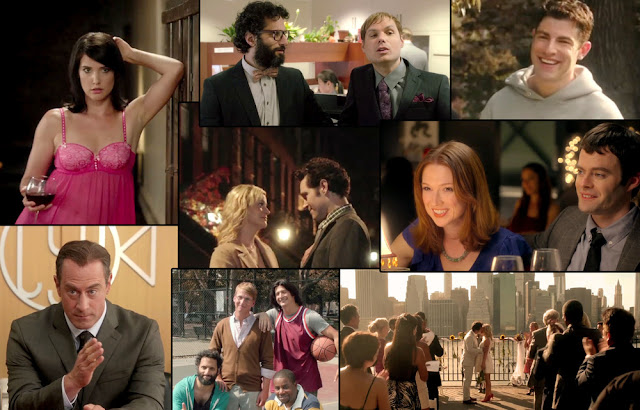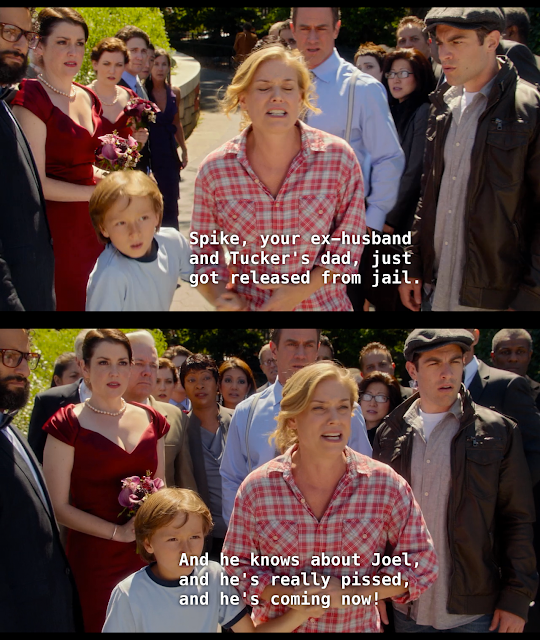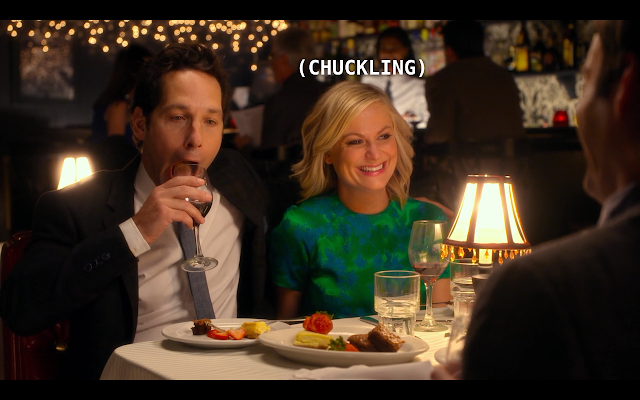I wasn't alive when the original Mission: Impossible first aired on CBS, and I didn't watch any of the Mission: Impossible reruns until I saw FX's badly butchered versions of them back when the future home of Vic Mackey and SAMCRO started out as a low-rent Nick at Nite, so I don't have an attachment to Jim Phelps like I do to other characters from shows I'm much more fond of, like, say, Yemana from Barney Miller or anybody from the Greendale gang who's not Pierce. When Brian De Palma's 1996 Mission: Impossible reboot picked Jon Voight to take over the Peter Graves role of Phelps, the cool-headed (and rather bland) leader of the Impossible Missions Force and the hero of both the '60s and '80s versions of the show, and the movie reimagined Phelps as a traitor who had his fellow IMF agents killed, I didn't hiss "Blasphemy!" at the screen or angrily storm out of the theater in the middle of the feature presentation like Graves' old Mission: Impossible co-star Greg Morris did when he watched De Palma's movie. I actually dug the shocking plot twist.
Action film reviewer Outlaw Vern perfectly described why the twist remains an intriguing one in his recent reassessment of De Palma's Mission: Impossible. A master of paranoid thrillers who proved to be the perfect filmmaker to revive and re-energize Mission: Impossible for these post-Cold War times, De Palma "doesn't look fawningly at the cloak and dagger Cold War fun of the ['60s] series... Using the original show's hero as the villain is not only a surprising plot twist, it's a statement." Vern added, "Back then spy shit was fun and glamorous, now we're more aware of the messes it causes, and the consequences of training people with deadly skills and then running out of things for them to do. The guy that was the hero back then is now willing to betray everyone because he's not getting paid enough. Times are tough."
While I found the first Mission: Impossible movie that Tom Cruise both starred in and co-produced to be genuinely thrilling and clever--the beauty of that classic Langley break-in sequence is mostly due to its use of silence, which was De Palma's way of critiquing the noisy storytelling of most summer blockbusters--the villainization of Phelps, which actually made Phelps slightly more interesting as a character, wasn't what bugged me about the movie. What bugged me was Cruise's de-emphasis on teamwork in the movie's third act so that his Ethan Hunt character saved the day on his own and everyone else on Hunt's makeshift team was ancillary. The emphasis on a team of specialists from different fields was what made both the '60s and '80s incarnations of Mission: Impossible stand out from other spy shows, besides the enticing concept of what was essentially a one-hour heist movie every week. If you're going to revive Mission: Impossible on the big screen, it ought to be the espionage equivalent of Seven Samurai or Ocean's Eleven like the old show was, or else why call it Mission: Impossible? Without an ensemble, it's nothing more than 007 as a two-hour shampoo commercial--which was basically what John Woo's abysmal Mission: Impossible II was.
The J.J. Abrams-directed Mission: Impossible III attempted to be more of an ensemble piece than Mission: Impossible Woo, but in the end, the threequel turned into yet another Cruise-saves-the-day-alone installment. It was also too much of a remake of Alias, with Cruise in the role of Sydney Bristow, Simon Pegg in the role of Marshall Flinkman and yet another guest appearance by the old Alias storytelling device of in medias res. Meanwhile, the grifter show Hustle and the caper show Leverage (as well as way before Hustle or Leverage and in the interval between the first and second Mission: Impossible movies, a lesser-known vigilante/private eye show called Vengeance Unlimited, in which Michael Madsen subjected the tormentors of his clients to mind games that owed a lot to the mind games of the small-screen IMF) were doing a better job of channeling the old Mission: Impossible than the actual Mission: Impossible movies themselves--until Mission: Impossible--Ghost Protocol came along in 2011.
Written by former Alias writer/producers Josh Appelbaum and André Nemec, Ghost Protocol recycles the premise of Hunt being falsely accused of wrongdoings and going on the run (this time to Dubai and Mumbai, after he and his team are framed for bombing the Kremlin) while trying to clear his name, which is starting to get old after two of the three previous movies featured the same thing. By now, Hunt ought to be asking himself, "How can the same shit happen to the same guy thrice?" However, the fourth installment is the closest the Cruise movies have gotten to capturing the ensemble spirit of the old show. It's clear from the start of Ghost Protocol that animator Brad Bird, directing his first live-action film, is an even bigger fan of the old show than either Cruise or Abrams have claimed to be, because Bird reverts to the show's practice of spoiling clips from the mission to come during the opening titles to get viewers excited and pumped (a practice later emulated by '60s Mission: Impossible alums Martin Landau and Barbara Bain's sci-fi show Space: 1999 and the Battlestar Galactica reboot). The only other Mission: Impossible movie to do that was the first one. You can tell someone's a millennial or teen who never watched both the old show and the 1996 movie whenever they tweet (or post in a comments section) a complaint about Ghost Protocol's opening titles containing too many spoilers.
I like to pretend Bird took Cruise aside and persuaded him to give his ego a rest to bring back the ensemble spirit of the show Bird grew up watching. The result is the most generosity we've seen from Cruise as a star and co-producer in the entire franchise (in fact, the film was originally intended to be a passing of the torch from Hunt, who was semi-retired in Mission: Impossible III, to Jeremy Renner's new character William Brandt). It explains why Jane Carter (Paula Patton), instead of Hunt, becomes the first Mission: Impossible character to light the fuse on-screen for the opening titles since Phelps in the '80s Mission: Impossible opening titles, and why the climax ends not with Hunt stopping the villainous Cobalt (Michael Nyqvist) by himself but with the teammates, despite being separated from each other, combining their efforts to stop the Swedish terrorist and his nuclear threat. Critics like to complain about how boring Ghost Protocol gets whenever it pauses from the action to dip into the angst of both Carter, who wants revenge for the killing of her lover and teammate Hanaway (Josh Holloway), and Brandt, who feels guilty for failing to protect Hunt's wife Julia (Michelle Monaghan, briefly reprising her Mission: Impossible III role to help wrap up a character arc that clearly turned into Cruise's way of coming to terms with the dissolution of his then-marriage to Katie Holmes), but thanks to Bird's skills with pacing, it's not boring. It makes Carter and Brandt more fully realized characters than Jonathan Rhys-Meyers and Maggie Q's forgettable (aside from Maggie Q's sultry entrance in a red evening gown) IMF agent characters in Mission: Impossible III.
As Ghost Protocol's female lead, Carter is an improvement over the damsel-in-distress roles written for the female leads in the second and third Mission: Impossible installments, which isn't surprising when Bird's the director, because of the assertiveness and agency he and his animators brought to Elastigirl in The Incredibles and Colette in Ratatouille. Carter's thirst for revenge also feels like Bird's comment on what went wrong with Mission: Impossible II and what caused Mission: Impossible III to take a turn for the generic in its third act. When Carter defies Hunt's orders to keep alive Sabine Moreau (Léa Seydoux), the assassin who killed Hanaway, for intel purposes and kills her instead, her act jeopardizes the mission. It's as if Bird's saying, "When you take teamwork out of the equation and have the characters act on their own, it's no longer the Mission: Impossible I used to enjoy on TV."
One of the most appealing elements of Ghost Protocol is the sight of Carter and the other agents making mistakes. It freshens up the franchise in the same way that De Palma brought his "all bets are off" stamp to Mission: Impossible by starting his movie out as a traditional Mission: Impossible episode where everything seems to go according to plan and then blindsiding the audience by killing off nearly all the agents the movie introduced only a few minutes before. In Ghost Protocol, Hunt and Pegg's Benji Dunn, left without the backing of the government due to ghost protocol going into effect and the IMF being disavowed and shut down, are forced to deal with gadgets that become unreliable without the resources to fix them, a storytelling thread Shane Black appeared to have borrowed somewhat when he opted for a similar back-to-basics, on-the-lam story for Tony Stark in Iron Man Three. Before the Kremlin disaster that triggers ghost protocol, Hunt receives his mission instructions from a recording that conks out and fails to self-destruct, so Hunt has to give the old Russian pay phone that was playing the recording a Fonzie-style whack to get the message to self-destruct. Then after the Kremlin disaster, the mask-building gadget the IMF has relied on since Mission: Impossible III breaks down, which deprives the team of the state-of-the-art masks that have become such a staple of the Cruise movies. During the much-talked-about Burj Khalifa climbing sequence where, like in the rest of Ghost Protocol, Cruise's brand of crazy is Jackie Chan crazy (he insisted on doing his own climbing stunts again) as opposed to Scientology crazy, one of Hunt's suction gloves malfunctions and turns into Hunt's worst enemy.
These gags are organic to Ghost Protocol's story in a way that the forced running gags about the Enterprise-A's ineffectiveness as a new ship were not during Star Trek V: The Final Frontier. The tech mishaps both raise the stakes of Ghost Protocol and act as a clever metaphor for the anxieties the Mission: Impossible producers must be having about maintaining the durability of a movie franchise that's now pushing 20, whereas all those Enterprise-A malfunction gags were there for no reason, other than because '70s Mission: Impossible alum Leonard Nimoy's Star Trek IV: The Voyage Home conquered the box office after adding more humor and both Paramount and William Shatner wanted another Star Trek IV without exactly understanding why the humor in Nimoy's directorial effort worked.
In fact, Ghost Protocol does several other things better than other movies do, whether that movie is Star Trek V or Hudson Hawk. Benji's playing of "Ain't That a Kick in the Head" to time Hunt's prison break at the start of Ghost Protocol appears to have been lifted from Bruce Willis and Danny Aiello's use of pop standards to time their heists in Hudson Hawk, but according to sci-fi author Christopher L. Bennett, a Mission: Impossible geek, it echoes "the use of carnival music to time a prison break in season 1's 'Old Man Out.'" Bird's background in animated storytelling explains why he's better at writing and directing humor than Shatner and maybe Michael Lehmann (I'm aware that Hudson Hawk has become as much of a cult favorite as Lehmann's earlier flick, the classic anti-John Hughes teen movie Heathers, in the decades since its disastrous release, but all I've watched of Lehmann's Hudson Hawk is the "Swinging on a Star" heist scene).
Bird's animation background also lends a lot of visual snap to Ghost Protocol's massively scaled set pieces, particularly the sequences in Dubai and the climactic Mumbai parking garage fight between Hunt and Cobalt. The strong visual sense Bird brought to Ghost Protocol is timeless in ways that the speed-ramping and second-rate CGI throughout Die Another Day, the fourth entry in Pierce Brosnan's run as 007 just like how Ghost Protocol is fourth in Cruise's franchise, are not. Those were a couple of attempts to visually transition 007 into the early '00s, but they ended up instantly dating Die Another Day and giving it a whiff of desperation (Bird's visual sense is also preferable over the fondness for shaky-cam both Abrams, who stayed on as co-producer on both Ghost Protocol and the new Rogue Nation, and his Star Trek and Star Wars cinematographer Dan Mindel brought over to Mission: Impossible III after Abrams made the camera wobble throughout Alias and the first season of Lost). It's a bit of a shame that Paramount denied Ghost Protocol fans the option on Blu-ray of rewatching Ghost Protocol's IMAX sequences in their original aspect ratio so that they can re-experience the awe of seeing Cruise and the other actors dwarfed by such tall surroundings, like during the Kremlin explosion and the Dubai sandstorm sequence.
The lack of an IMAX viewing option also kind of waters down the great visual joke of Bird and cinematographer Robert Elswit framing Cruise in certain shots so that he looks like little Remy scampering through the kitchen and the streets of Paris during Ratatouille. Both that 2007 Pixar flick and The Incredibles concluded with inventive title sequences that were worth staying in the theater for a few more minutes to enjoy, but the opening title sequence Kyle Cooper's Prologue Films company created for Ghost Protocol is easily the most entertaining title sequence in a Bird movie, especially when it's in full IMAX, which adds more frustration to the Ghost Protocol Blu-ray's lack of an IMAX option. The old imagery of the Mission: Impossible fuse passing through sneak peeks at future scenes nicely receives a more immersive, 3-D-inspired spin from Prologue, which follows the fuse as it zooms and plummets like a roller coaster through those yet-to-come scenes, shot from angles that are completely different from how we later see them in full.
Ghost Protocol's opening title sequence is a great marriage of visuals and music. Mission: Impossible III composer Michael Giacchino's reunion with Bird, whom he wrote outstanding score music for during The Incredibles and Ratatouille, seemed to have amped up Giacchino during Ghost Protocol, because he came up with my favorite modern arrangement of Lalo Schifrin's Mission: Impossible opening title theme, outshining even Danny Elfman's loving reinterpretations of the theme in the first movie. I love how the rhythm of Giacchino's "Light the Fuse" responds to the clips of Benji's modification of a hotel room number, the Hunt/Brandt gun snatch scene and the Indian dancers during the opening titles. But the best element of Giacchino's Ghost Protocol revamp of the Schifrin theme has to be his rearrangement of the strings. In a 2011 interview, Giacchino said, "Traditionally in that [Schifrin] tune the strings are used in a very specific way. You have the low strings doing the obvious 'Bom, Bom, Bom-Bom,' and then you have the upper strings following along with the woodwinds playing the melody... One of the things I wanted to do was not necessarily have the strings play any of the melody, just give us the energy behind the melody. That's why they are just going 'Bop-pa-pa, Bop-pa-pa...'" Giacchino also came up with my favorite movie theme written for a skyscraper, the epic "A Man, a Plan, a Code, Dubai" cue that introduces the Burj Khalifa.
"The Plot," the march theme Schifrin first created for the Mission: Impossible pilot episode to represent the professionalism of the IMF agents while under enormous pressure, resurfaces in Giacchino's Ghost Protocol score, and its return appearance lends credence to my theory that the more a Mission: Impossible movie uses "The Plot," the more enjoyable the installment. Elfman included "The Plot" in his score for the first movie. Giacchino previously referenced "The Plot" in his Mission: Impossible III score. Rogue Nation composer Joe Kraemer, who regularly collaborates with Rogue Nation director Christopher McQuarrie, makes use of "The Plot" even more than Giacchino does, which is a sign that Rogue Nation might not be terrible. Meanwhile, Hans Zimmer never featured "The Plot" in his Mission: Impossible II score. Mammoth box-office grosses aside, we know how that sequel turned out.
But even if Giacchino didn't use "The Plot" at all, Ghost Protocol would still tower over the second and third Mission: Impossible movies like the Burj Khalifa looming over Dubai, simply because of Bird's ability to find the perfect balance of spectacle, suspense and humor while fully restoring the most missed element of the old Mission: Impossible: the teamwork. Sure, Ghost Protocol lacks a villain as intimidating and perfectly realized as the late Philip Seymour Hoffman was in Mission: Impossible III. Nyqvist is too much of a non-entity as Cobalt. Despite having such minimal dialogue, Seydoux makes so much of an impression as an adversary--with her sexy pouts and Beyoncé hair--that I wish Ghost Protocol contained a Ra's Al Ghul-style twist where Cobalt turned out to be a decoy for the real mastermind behind the nuclear threat, Sabine, which would have given the Blue Is the Warmest Color star more screen time. But otherwise, Bird understands that Mission: Impossible stories work best as what the A.V. Club's A.A. Dowd describes as "tributes to process, when they're observing the detail-oriented business of breaking into an impregnable fortress or pulling a technology-abetted heist." It would be a crime if the franchise were to disavow any knowledge of that.
Selections from Giacchino's Ghost Protocol score are in rotation during both "AFOS Prime" and "AFOS Incognito."


















